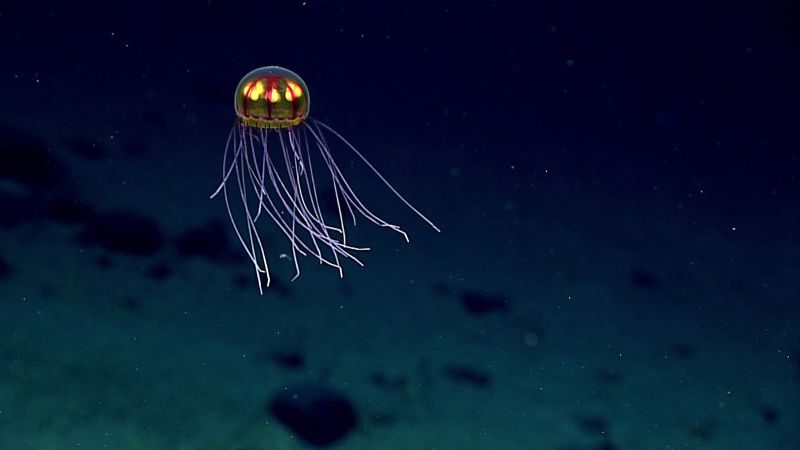The submersible vehicle that was lost at sea is part of a relatively new effort enabling tourists and other paying customers to explore the depths of the ocean, the vast majority of which has never been seen by human eyes.
Though people have been exploring the ocean’s surface for tens of thousands of years, only about 20% of the seafloor has been mapped, according to 2022 figures from the National Oceanic and Atmospheric Administration.
Researchers often say that traveling to space is easier than plunging to the bottom of the ocean. While 12 astronauts have spent a collective total of 300 hours on the lunar surface, only three people have spent around three hours exploring Challenger Deep, the deepest known point of Earth’s seabed, according to the Woods Hole Oceanographic Institution.
In fact, “we have better maps of the moon and Mars than we do of our own planet,” said Dr. Gene Feldman, an oceanographer emeritus at NASA who spent more than 30 years at the space agency.
There’s a reason deep-sea exploration by humans has been so limited: Traveling to the ocean’s depths means entering a realm with enormous levels of pressure the farther you descend — a high-risk endeavor. The environment is dark with almost no visibility. The cold temperatures are extreme.
The submersible, which is believed to have been destroyed in a catastrophic implosion, killing all five people aboard, was en route to explore the wreckage of the RMS Titanic. The remnants of the ship lie about 900 miles (1,450 kilometers) off the coast of Cape Cod, Massachusetts, and about 12,500 feet (3,800 meters) underwater. Operated by OceanGate Expeditions, a private company based in Washington state, the tourist vessel lost contact with its mother ship after departing on Sunday.
The US Navy later revealed that it had detected a sound on Sunday that would match an implosion, indicating the vessel, called the Titan, was rapidly destroyed. The disaster could have occurred during the submersible’s descent, as pressure on the vehicle grew.
Many of the factors that made the multiday search for the vessel so difficult are also the reasons a comprehensive exploration of the ocean floor remains elusive.
“Aquatic search is pretty tricky, as the ocean floor is a lot more rugged than on land,” said Dr. Jamie Pringle, a reader in forensic geoscience at England’s Keele University, in a statement.
In the days before the submersible’s likely implosion was confirmed, search and rescue teams relied on sonar, a technique that uses sound waves to explore the opaque depths of the ocean, to attempt to pinpoint the vehicle in case it had been stranded on the seafloor. Thechallenging process requires a very narrow beam with a high frequency to offer a clear picture of where objects might be.
The first submarine was built by Dutch engineer Cornelis Drebbel in 1620, but it stuck to shallow waters. It would take nearly 300 years — in the aftermath of the Titanic disaster — before sonar technology began to offer scientists a clearer picture of what lies in the ocean’s depths.
A major step forward in human exploration came in 1960 with the historic dive of the Trieste bathyscaphe, a type of free-diving submersible, to the Challenger Deep, located more than 35,800 feet (10,916 meters) underwater.

Only a few missions since have returned to such depths. And the trips are extremely dangerous, Feldman said.
For every 33 feet (10 meters) traveled beneath the ocean’s surface, the pressure increases by one atmosphere, according to NOAA. An atmosphere is a unit of measure that’s14.7 pounds per square inch. That means a trip to the Challenger Deep can put a vessel under pressure that is “equivalent to 50 jumbo jets,” Feldman noted.
At high pressure, the tiniest structural defect can spell disaster, Feldman added.
During the 1960 dive of the Trieste, passengers Jacques Piccard and Don Walsh said they were stunned to see living creatures.
“Right away, all of our preconceptions about the ocean were blown out the window,” Feldman said.
While what’s considered the deep ocean extends from 3,280 feet to 19,685 feet (1,000 meters to 6,000 meters) beneath the surface, deep-sea trenches can plunge to 36,000 feet (11,000 meters), according to the Woods Hole Oceanographic Institution in Massachusetts. This region, called the hadal or hadalpelagic zone, is named for Hades, the Greek god of the underworld. In the hadal zone, the temperatures are just above freezing, and no light from the sun penetrates.
Scientists were first able to prove that life existed below 19,685 feet in 1948, according to the institution.
Discoveries at the Challenger Deep have been remarkable, including “vibrantly colorful” rocky outcrops that could be chemical deposits, prawnlike supergiant amphopods, and bottom-dwelling Holothurians, or sea cucumbers.
Feldman also remembers his own attempt in the 1990s to catch a glimpse of the evasive giant squid, which lurks in the inky depths of the ocean. The first video of a live creature, which can grow to nearly 60 feet (18 meters) long, was captured in the deep sea near Japan in 2012, according to NOAA.
A new world also opened in the 1970s, Feldman said, when “an entirely alien ecosystem” was discovered by marine geologist Robert Ballard, then with the Woods Hole Oceanographic Institution, within the sea near the Galápagos Rift — “with these giant worms, giant clams, and crabs and things that lived at these … vents under the sea.”

The unusual creatures — some of which glow with bioluminescence to communicate, lure prey and attract mates — have carved out habitats within the steep walls of ocean trenches. These life forms have adapted to live in the extreme environment and don’t exist anywhere else on the planet. Instead of relying on sunlight for fundamental processes, they use chemical energy belched out from hydrothermal seeps and vents formed by magma rising from beneath the ocean floor.
The chilly seawater seeps through seafloor cracks and becomes heated to 750 degrees Fahrenheit (400 degrees Celsius) as it interacts with the magma-heated rocks. The chemical reactions produce minerals containing sulfur and iron, and the vents spew out the nutrient-rich water that supports the ecosystem of unusual marine life clustered around them.
Researchers have used the submersible Alvin to discover strange sea life, study plate tectonics and hydrothermal vents — and to explore the Titanic in 1986 after Ballard located the famed shipwreck.
Researchers from the WHOI and NASA have collaborated to develop uncrewed autonomous underwater vehicles that can descend through the tricky terrain of the trenches and withstand pressures greater than 1,000 times that at the ocean’s surface. The vehicles can investigate the diversity of life within the trenches, and they could also help scientists explore oceans on the moons around Jupiter and Saturn in the future.

From a strictly scientific perspective, touristic trips to the ocean floor do little to advance our understanding of the ocean’s mysteries.
“Humans like superlatives,” Feldman said. “We want to go to the highest, the lowest, the longest.”
But only a “very small percentage of the deep ocean, and even the middle ocean, has been seen by human eyes — an infinitesimal amount. And a very, very small amount of the ocean floor has been mapped,” he added.
The reason, Feldman noted, largely comes down to cost. Boats equipped with sonar technology can rack up exorbitant expenses. Fuel alone can total up to $40,000 per day, Feldman said.
There is, however, currently an effort underway to create a definitive map of the ocean floor, called Seabed 2030.
Still, there are huge gaps in what’s known of the deep sea. Of the 2.2 million species believed to exist in Earth’s oceans, only 240,000 have been described by scientists, according to the Ocean Census, an initiative to record and discover marine life.
However, it’s impossible to know for certain just how many sea creatures exist, Feldman noted.

“We can make estimates all the time but then … you go somewhere new and discover an entirely new genus or an entirely new way of living,” he said.
Advances in technology may make human exploration of the ocean depths unnecessary. Innovations such as deep-sea robots, high-resolution underwater imaging, machine learning, and sequencing of DNA contained in seawater will help accelerate the speed and scale of discovery of new life forms.
“We have better maps of the moon’s surface than of the seafloor because seawater is opaque to radar and other methods we use to map land,” said marine ecologist Alex Rogers, a professor of conservation biology at the University of Oxford in the United Kingdom. “However, 150 years of modern oceanography have led to better understanding of many aspects of the ocean such as the life it contains, its chemistry and its role in the Earth system.”
Mapping the ocean “helps us to understand how the shape of the seafloor affects ocean currents, and where marine life occurs,” Rogers added. “It also helps us to understand seismic hazards. So it is basic fundamental science of overwhelming importance to human well-being.”
Human health and scientific research
The ocean is thought to be a gold mine of compounds, and its exploration has led to several biomedical breakthroughs.
The first marine-derived drug, Cytarabine, was approved in 1969 for the treatment of leukemia. The medication was isolated from a marine sponge.
Work on bioactive compounds in the venom of cone snails, a type of sea mollusk, led to the development of a potent pain reliever called ziconotide (commercially known as Prialt).
Scientists developed PCR, or polymerase chain reaction, a technique widely used to copy strands of DNA, with the help of an enzyme isolated from a microbe found in marine hydrothermal vents. And a green fluorescent protein observed in jellyfish allows researchers to watch once-invisible processes, including the spread of cancer cells and the development of nerve cells.
These are just a few examples. Researchers say the ocean and the life it contains could provide answers to some of medicine’s biggest challenges, such as antibiotic drug resistance. Studying the sea can also tell us about how life evolved.
“The ocean contains many more of the deep branches of life that have evolved over 4 billion years on Earth and so marine life can tell us a lot about the evolution of both whole organisms and specific biological systems such as developmental genes and immune system,” Rogers said via email.





